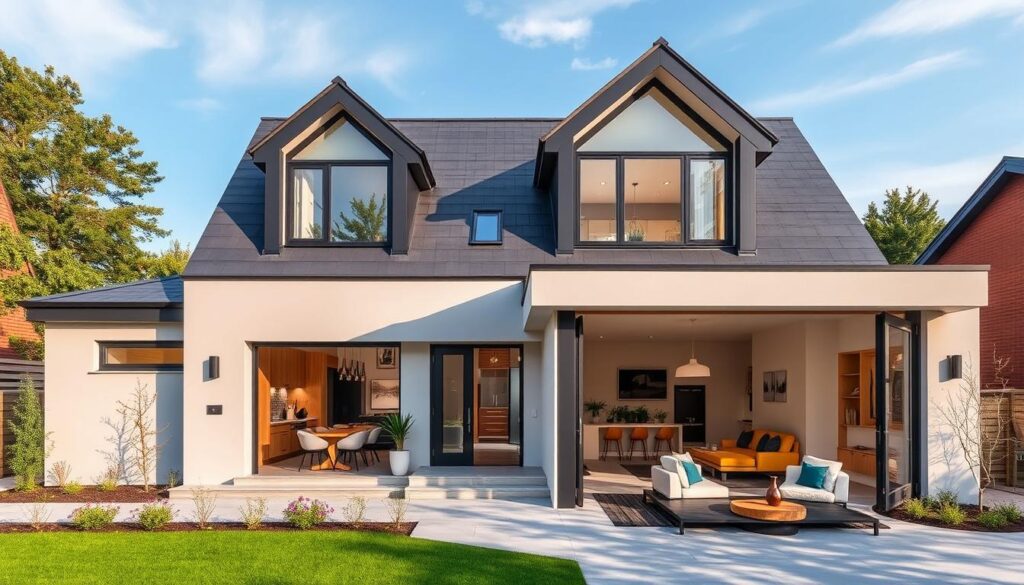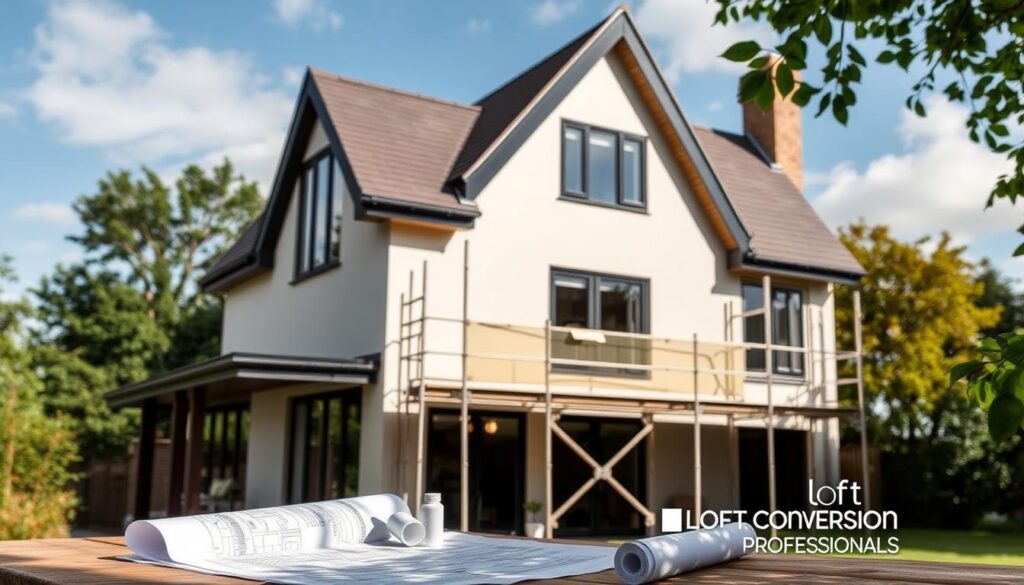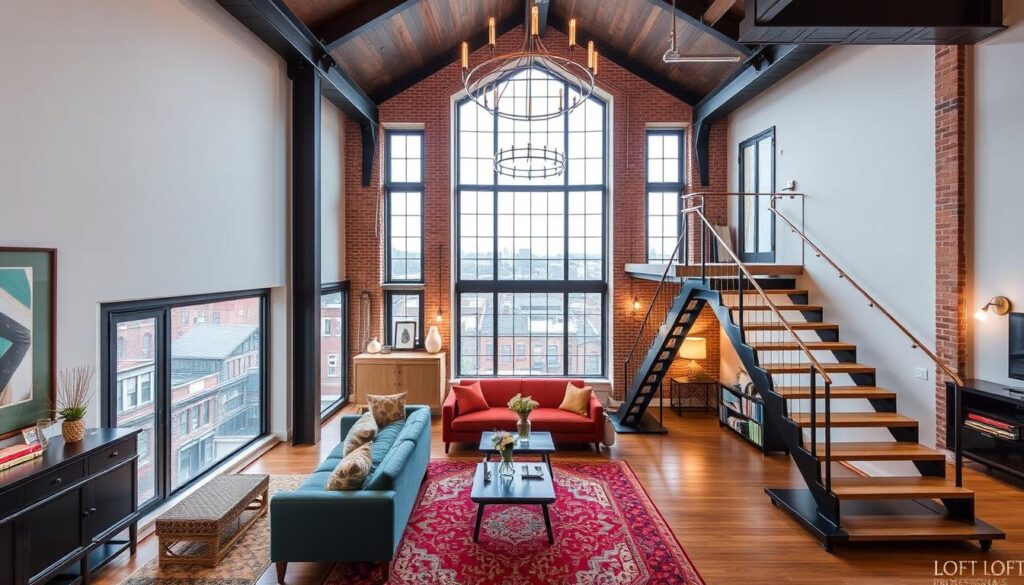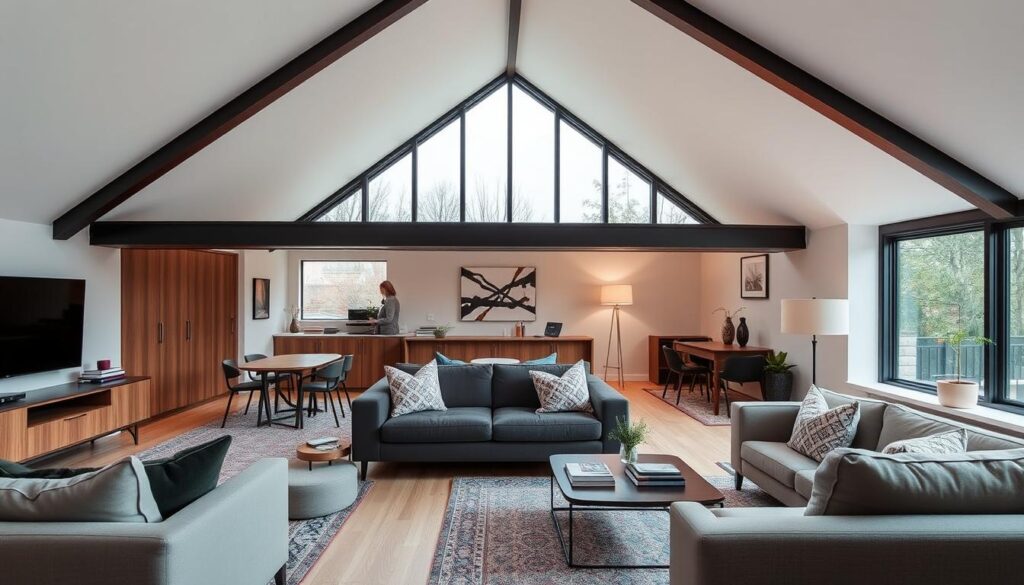Hip To Gable Loft Conversion
Start your journey to space maximisation with a hip to gable loft conversion. As a smart homeowner in the UK, knowing about attic remodelling is key. It helps you use your roof space well, boosting your property enhancement.
This guide shows how to turn a messy attic into a beautiful living area. See how unused space can become something amazing.

Key Takeaways
- Understanding the transformative impact of hip to gable conversions on home space utilisation.
- Learning about the benefits and increased value a loft conversion can bring to your property.
- Diving into the essentials of planning permission and building regulations within the UK context.
- Exploring tailored design and material selection for attic conversions that compliment your home’s aesthetics.
- Considering the financial aspects and selecting a reputable contractor to actualise your vision.
- Examining the potential timeline from conception to realisation of a loft conversion project.
Understanding Hip to Gable Loft Conversions
A hip to gable loft conversion is a great way to add more space to your home. It changes the sloping roof into a vertical wall, making the loft area bigger. This is perfect for homes with hip roofs, as it not only adds space but also looks better.
Understanding this change means seeing the potential of attic space. Many homes have big attic areas that are not used because of the roof shape. By making the roof side into a gable end, these areas become brighter, easier to get to, and more useful.
Renovating the loft involves big changes to the structure. You need to strengthen the floor joists, put in new roofing, and change the plumbing and electrical systems.
“Hip to gable conversions are one of the most effective ways to add space and value to your home, turning previously underused attic areas into vibrant and habitable parts of the property.”
Steps Involved in Hip to Gable Loft Conversions:
- First, check the roof and attic space.
- Then, design the new look, making sure it’s both good-looking and strong.
- Next, get the necessary permissions and follow building rules.
- After that, start building the new roof and gable end.
- Finally, add the inside details like wiring, insulation, and plumbing.
Done well, a hip to gable roof extension adds space and makes your home look and work better. It’s a top choice for anyone wanting to improve their home.
The Benefits of Converting Your Loft
A hip to gable loft conversion is more than a simple upgrade. It’s a smart investment that can greatly increase your home’s value. With custom interiors and unique designs, these conversions are a top choice in the property market. Here’s how a loft conversion can benefit your property:
Increased Property Value
One big advantage of a loft conversion is the boost in your home’s value. In areas where space is limited, adding a bedroom or en suite bathroom makes your home more appealing. This not only looks better but also increases your investment return.
Additional Living Space
Loft conversions can solve the problem of not enough space in homes. They’re great for families or for those who work from home. Adding an en suite bathroom adds privacy and luxury, making your home more desirable.
Custom Design Opportunities
Hip to gable conversions let you personalise your space. You can design every detail to fit your style and needs. This creates a space that reflects your taste and meets your lifestyle.
Custom interiors and unique layouts in a loft conversion make your home more attractive. They also increase its marketability and functionality, proving it’s a wise financial choice.
| Feature | Benefits |
|---|---|
| Bespoke Interior | Increases property uniqueness and aesthetic appeal. |
| Extra Bedroom | Boosts home valuation and attracts family-oriented buyers. |
| En Suite Bathroom | Adds luxury, convenience, and overall value to property. |
| Home Office | Meets modern work-from-home demands, increasing buyer interest. |
Is Your Property Suitable for a Hip to Gable Conversion?
Before starting a hip to gable loft conversion, it’s key to do a suitability assessment. This check looks at the property type and conversion feasibility. It makes sure the building’s design and local rules match your plans.
The roof structure of your property is the first thing to think about. Hip to gable conversions work best with hipped roofs. These roofs have a slope on the sides, common in detached, semi-detached, and end-terrace houses.
Local planning rules also play a big part in whether you can convert your loft. These rules change from one council to another. Knowing if your property is in a conservation area or listed can affect what changes you can make.
| Property Type | Typical Suitability | Notes |
|---|---|---|
| Detached House | Highly suitable | Usually offers more flexibility for extension. |
| Semi-detached House | Highly suitable | May require neighbour’s consent if sharing a party wall. |
| End-terrace House | Generally suitable | Similar to semi-detached but often with additional side space. |
| Mid-terrace House | Less suitable | Limited external expansion options can restrict designs. |
| Flat or Apartment | Not suitable | Structural and ownership complexities present major hurdles. |
Homeowners should think about the long-term effects of a hip to gable conversion. It can add living space and possibly boost your home’s value. But, it needs careful planning and design to fit well with your home and area.
In conclusion, deciding if a hip to gable loft conversion is right for you involves many factors. It’s wise to talk to experts to go over your situation and do a detailed study before starting.
Hip to Gable Loft Conversion Planning Permission
Understanding planning permission is key for anyone thinking about a hip to gable loft conversion. In the UK, you must navigate a complex set of planning laws and compliance rules. This ensures your project is legal and meets local standards.
Navigating UK Building Regulations
It’s vital to know about permissible development rights when planning your loft conversion. These rights let homeowners make some changes without needing full planning permission. But, for a hip to gable conversion, you should talk to architectural services and planning consultants. They can check if your project meets these rights and follows UK building rules.

The rules cover things like the size of the extension, the materials used, and how it affects neighbours. Not following these rules can lead to fines and having to undo any illegal changes.
The Importance of Seeking Professional Advice
UK planning laws and building rules are complex. Getting legal guidance from planning consultants is a good idea. They can help with getting planning permission and making sure your conversion follows local laws.
Experienced architects can also help. They can make sure your loft conversion is both legal and looks great. With good planning and professional help, your project is more likely to succeed, making it a good investment.
Design Considerations for Your Loft Conversion
When you start a loft conversion, think about both looks and function. You want a space that’s not just pretty but also useful. You’ll need to decide on things like how to let in more light and what materials to use.
Choosing the right materials is key. They should be good for the planet and keep your home warm. This means picking materials that are eco-friendly and insulate well.
Maximising Natural Light
Bringing in more natural light is a top priority. Skylights and dormer windows are great for this. They turn dark attic spaces into bright, airy rooms.
These features not only make your home look better. They also save energy by cutting down on the need for artificial light.
Choosing the Right Materials
Picking the right materials is vital for a long-lasting, warm, and green loft conversion. Use sustainable building materials like recycled steel or wood from sustainable sources. Cork is another good option.
Choosing materials that are good for the planet and look good is important. The right materials should fit well with your home and offer the benefits of modern living.
Hip To Gable Loft Conversion
A hip to gable loft conversion is a great way to make the most of attic space. It’s perfect for homes with sloping roofs. This method adds more living space through a side roof extension.

This conversion changes the roof by adding a vertical gable end. It’s great for detached and semi-detached homes. It increases the roof and the internal space, without changing how the house looks outside.
This type of loft conversion needs structural work. This includes strengthening the rafters or adding new ones. It adds valuable square footage to your home. This conversion also makes the most of the space you already have.
| Feature | Benefits |
|---|---|
| Maximised Space | Converts unused attic areas into functional living spaces like bedrooms or offices. |
| Bespoke Design | Custom-designed to fit the unique dimensions and aesthetics of your house. |
| Increase Property Value | Enhances overall property value by adding extra living space and functional appeal. |
Looking for a unique home improvement? A hip to gable loft conversion is a smart choice. It not only adds space but also improves your home’s character and usefulness. This conversion shows how creative space optimisation and design can be.
Costs Involved in a Loft Conversion
Turning your attic into a living space comes with financial planning. You need to understand conversion costs, manage your investment, and find cost-effective solutions. This part will cover the financial side and how to manage your loft conversion project well.
Understanding the Financial Investment
Loft conversions add space but are a big financial step. Good budget planning is key to making it work without losing quality. Knowing the typical costs helps homeowners plan and make smart choices.
Ways to Manage Conversion Costs
Finding affordable ways to convert your loft is crucial. Smart investment means spending on what adds the most value to your home. This way, every penny spent boosts your property’s worth and comfort.
- Always have a contingency fund for unexpected costs to keep the project smooth.
- Think about doing the conversion in phases to spread out the cost over time. This can be easier on your budget.
- Get quotes from several contractors to find the best price and quality.
Below is a table showing how to manage different parts of a loft conversion to save money:
| Project Component | Typical Cost Percentage | Suggested Budget Strategy |
|---|---|---|
| Materials | 40% | Opt for bulk purchasing discounts |
| Labor | 30% | Engage local skilled labor |
| Design and Planning | 20% | Use cost-effective design solutions |
| Contingency Fund | 10% | Maintain for unforeseen expenses |
With careful budget planning and looking for cost-effective solutions, you can lessen the financial load of loft conversions. Smart financial moves lead to affordable conversions that increase your home’s value and function.
Selecting the Right Contractor for Your Conversion
Choosing the right contractor for your hip to gable loft conversion is crucial. The contractor reliability, skill, and experience can greatly affect the project’s quality and timing. It’s important to pick qualified builders and specialist loft converters with a good track record.
Qualified builders handle the structural parts of your conversion. They make sure everything is up to code and done with precision. Specialist loft converters have the skills to make the most of your attic space. They deal with the unique challenges of loft expansions.
Choosing a contractor is not just about cost efficiency; it’s about partnering with a team that you can trust to deliver a high-quality end product that aligns with your expectations.
Here are some tips to help you choose the right contractor:
- Look for extensive portfolios that showcase previous conversions, giving you an insight into their capability and style.
- Check for membership in recognised building and construction bodies which often reflect a commitment to industry standards and continuous professional development.
- Ask for client references or read reviews to judge their reliability and client satisfaction.
- Ensure they provide a comprehensive contract and warranty, demonstrating their accountability and professionalism.
Here’s a comparison of key aspects to consider when selecting your contractor:
| Criteria | Why It Matters | What to Look For |
|---|---|---|
| Experience | Experienced contractors are well-versed in managing the complexities of loft conversions. | A history of delivering similar projects successfully. |
| Accreditations | Indicates professionalism and adherence to safety and quality standards. | Memberships in organisations like the Federation of Master Builders. |
| Insurance and Warranty | Protects you against construction-related anomalies and future defects. | Comprehensive coverage that assures safety and investment value. |
| Client Reviews | Feedback can provide real insights into the contractor’s delivery and handling of client relations. | Positive feedback and resolution of issues. |
Project Timeline: What to Expect During the Conversion
Starting a hip to gable loft conversion is thrilling. It makes your home more useful and increases its value. Good project management is key to a smooth process. We’ll show you a typical timeline, with important conversion milestones and timeline planning tips to get you ready.
Initial Consultation to Project Completion
The journey from dreaming to reality involves several key steps. The first meeting sets the tone, discussing design, challenges, and schedules. Then, getting planning permissions takes several weeks, depending on local rules.
After permissions, construction starts. This usually takes 8 to 12 weeks.
Managing Disruption During Construction
During building, it’s vital to keep the household impact and minimising inconvenience in mind. Talking to your contractor helps manage what to expect. Try to keep daily life as normal as possible while the work is done.
Be ready for noise, dust, and possible moving around your home. This can help reduce the disruption.
| Phase | Duration | Key Activities |
|---|---|---|
| Pre-Construction | 1-4 Weeks | Consultations, Design Approval, Permit Acquisition |
| Core Construction | 8-12 Weeks | Structural Changes, Electrical Work, Roofing |
| Finalisation | 2-3 Weeks | Inspections, Interior Decorations, Cleanup |
Knowing this timeline and what each phase involves helps. It keeps your project on track and manages your expectations and household impact.
Interior Design Tips for Loft Spaces
Turning your loft into a lively space needs smart design. Use built-in storage and space-saving furniture to keep things tidy. This way, you get a neat and stylish place that shows off your taste.

Smart Storage Solutions
Keeping your loft tidy is key. You’ll need clever storage like wall cabinets and under-eaves shelves. These not only hold lots but also look good, fitting well with your loft’s look.
- Wall-mounted shelves for books and decor
- Drawers integrated into staircases
- Custom built cabinets that utilise awkward corner spaces
Decor Ideas for Loft Bedrooms
Loft bedrooms should feel both open and snug. Use low-profile furniture and glass partitions to make it look great. Soft lighting and bold colours add warmth and style, making it a lovely place to relax.
| Element | Function | Design Impact |
|---|---|---|
| Low-profile bed | Maximises vertical space | Enhances sense of spaciousness |
| Glass partitions | Separates sleeping area without blocking light | Creates an airy, open feel |
| Soft ambient lighting | Provides gentle illumination | Adds warmth and comfort |
| Textured bed linens and curtains | Enhances comfort and style | Introduces colour and texture, boosting aesthetic appeal |
Adding these touches to your loft makes it both useful and charming. It becomes a space that’s both spacious and uniquely yours.
Maintenance and Upkeep of Your New Loft Space
Keeping your loft durable for the long term needs regular care. This guide offers post-conversion advice to help you keep your loft in top shape.
- Regularly check and maintain roofing and insulation to prevent heat loss and water ingress.
- Inspect windows and seals bi-annually to ensure they are secure and weatherproof.
- Clean and service air ventilation systems to sustain air quality and efficiency.
- Examine plumbing and electrical systems periodically by a certified professional.
It’s also key to follow a schedule for both seasonal tasks and wear and tear.
| Season | Maintenance Task | Benefit |
|---|---|---|
| Spring | Clean gutters and check roof tiles | Prevents water damage and dampness |
| Summer | Service air conditioning units | Enhances cooling efficiency |
| Autumn | Seal any drafts, inspect heating | Prepares loft for colder months |
| Winter | Check insulation, pipes for freezing | Prevents burst pipes and heat loss |
Looking after your loft is vital for its durability and safety. Ensure your loft lasts long with consistent care and expert advice.
The secret to enjoying your loft for years is regular maintenance and quick fixes. By following these tips, you can avoid common problems and create a strong, lasting space.
Real-Life Transformation Stories
Starting a loft conversion is more than just adding space. It’s about changing homes and lives. We look at the stories of homeowners who chose a hip to gable loft conversion. They share the amazing visual transformation and the big renovation impact in their lives.
Case Studies and Testimonials
We dive into the customer experiences and loft conversion feedback that made these projects a success. Each story gives us a peek into their decisions, the challenges they faced, and their joy at the end. These are not just success stories. They show how renovation can truly change a home.
- The mix of modern features with the old home’s charm.
- Creating more space for families to grow.
- Going beyond looks with creative design and personal touches.
Before and After Gallery
Our gallery showcase shows the real change of loft conversions. Before and after photos prove how these changes improve looks and use. This visual journey shows the big change and sparks ideas for others.
For those thinking about a loft conversion, these galleries are more than inspiration. They’re a clear guide of what can be done. As you see each photo change, you see the hard work and skill in each project.
In short, these real-life examples show more than just extra space. They show a big change in lifestyle and value, making a strong case for home improvements.
Conclusion
In this guide, we explored the details of hip to gable loft conversions. We highlighted the many benefits they offer, like changing your living space. This journey showed how a good conversion can improve your home’s look, use, and value.
Expanding your home with a loft conversion is a big step. It needs careful planning and the right advice. You must consider your property’s suitability, planning rules, and building regulations in the UK. Every choice, from materials to contractors, affects the outcome.
As we conclude, remember that a successful loft conversion requires hard work and expertise. It’s an investment in your home’s future and your family’s happiness. With the knowledge from this article, you’re ready to start a project that will exceed your expectations.
FAQ
What is a hip to gable loft conversion?
A hip to gable loft conversion changes a roof’s side, called a ‘hip’, into a vertical wall. This makes more space in the attic. It’s a great way to increase your home’s space and look.
How can a loft conversion transform my home?
Adding a loft conversion can give you more room, like extra bedrooms or a home office. It lets you design it your way, boosting your home’s value and appeal.
What are the key benefits of converting my loft?
Benefits include higher property value and more space. You can also make it your own with custom designs. This makes your home look better and feel more personal.
How do I determine if my property is suitable for a hip to gable conversion?
Check if your property fits by looking at its type, roof, and local rules. A professional can assess if it’s possible based on laws and design.
Will I need planning permission for a hip to gable loft conversion?
Planning permission rules change by location and project size. Many loft conversions don’t need permission, but UK laws must be followed. Get advice from experts to ensure you’re legal.
What should I consider in the design of my loft conversion?
Think about using skylights for more light, choosing green materials, and good insulation. Make sure it looks good and fits your home’s style.
Are there cost-effective solutions for managing my loft conversion expenses?
Yes, plan your budget well, focus on what’s important, and look for affordable options. You can also do it in stages to save money. Good planning helps stay within budget without losing quality.
How do I choose the right contractor for my hip to gable loft conversion?
Choosing the right contractor is key. Look for experienced builders with good feedback. They should have the right skills and experience to do a great job.
What is the typical project timeline for a hip to gable conversion, and how can I manage disruption?
The project can take weeks or months, depending on the work. Plan well, communicate clearly, and make temporary arrangements to reduce disruption.
Can you offer interior design tips for newly converted loft spaces?
Use smart storage and furniture that saves space. Choose stylish decor that fits your home’s theme. This makes your loft feel like part of your home.
How should I maintain and upkeep my new loft space?
Keep it clean, check the structure, and fix problems quickly. Follow care tips for materials and ensure good insulation and ventilation. This keeps your loft in top condition.
Where can I find real-life transformation stories and testimonials on loft conversions?
Look on contractor websites, forums, and blogs for stories and feedback. Before and after photos show the impact and inspire you.
